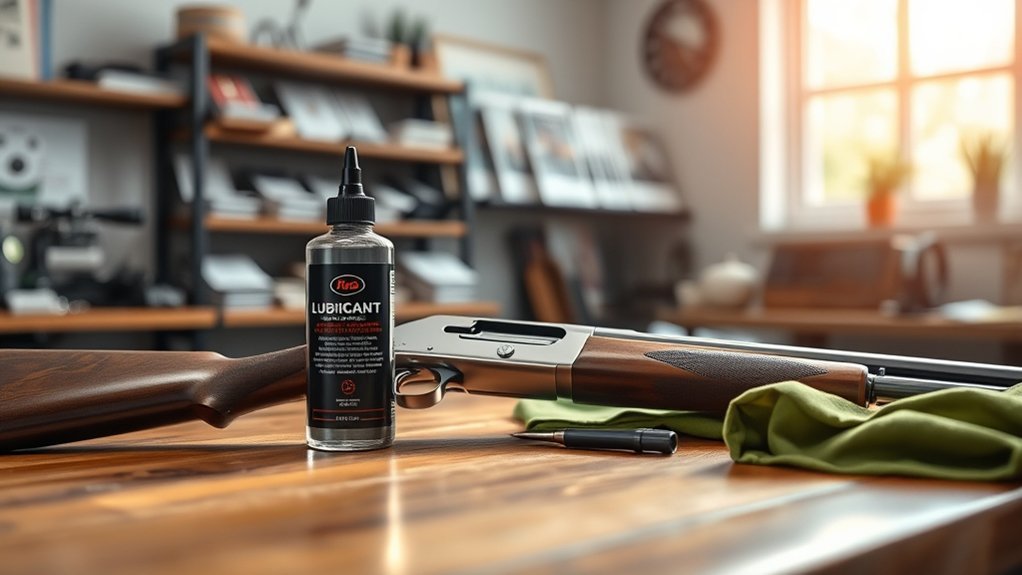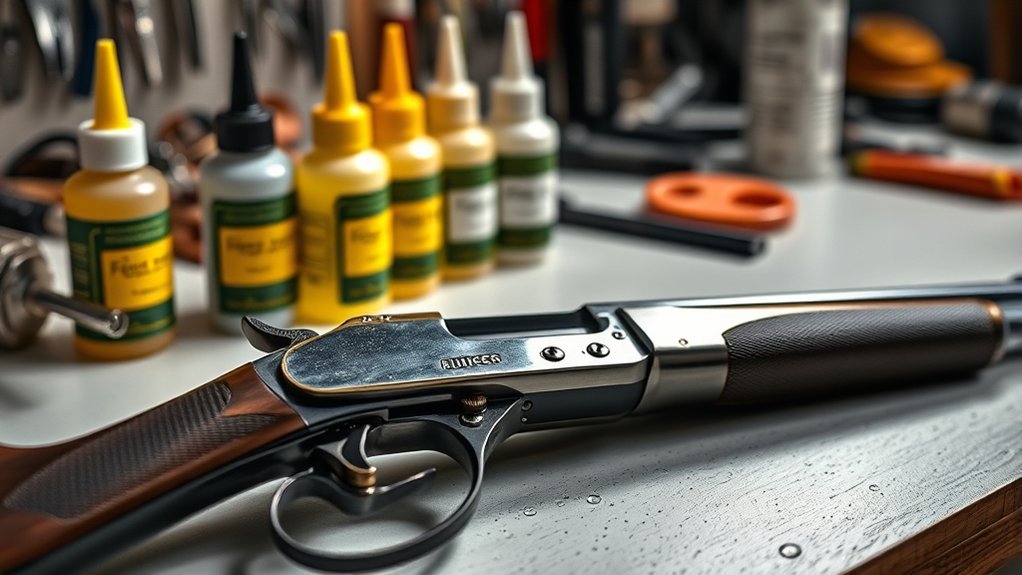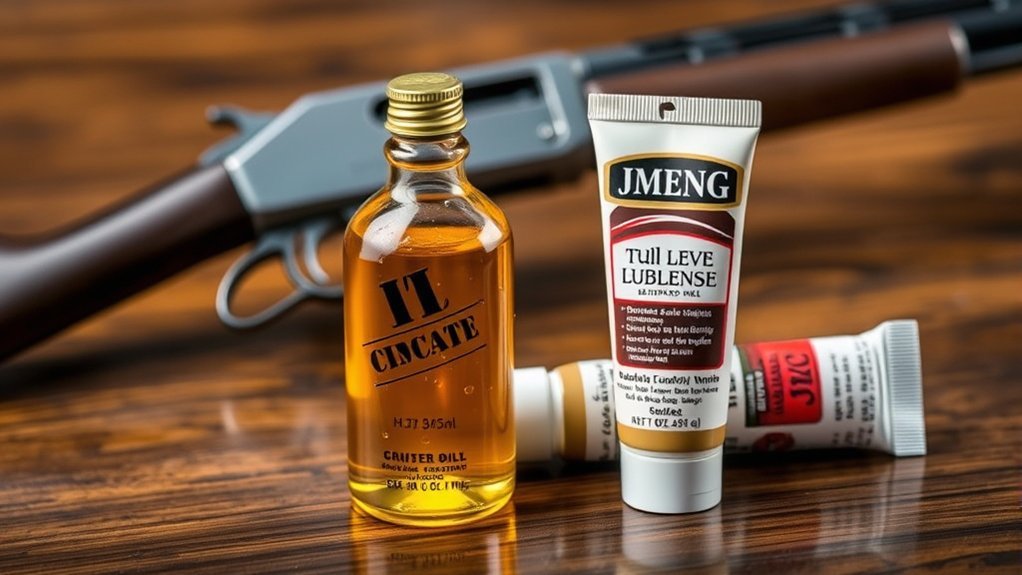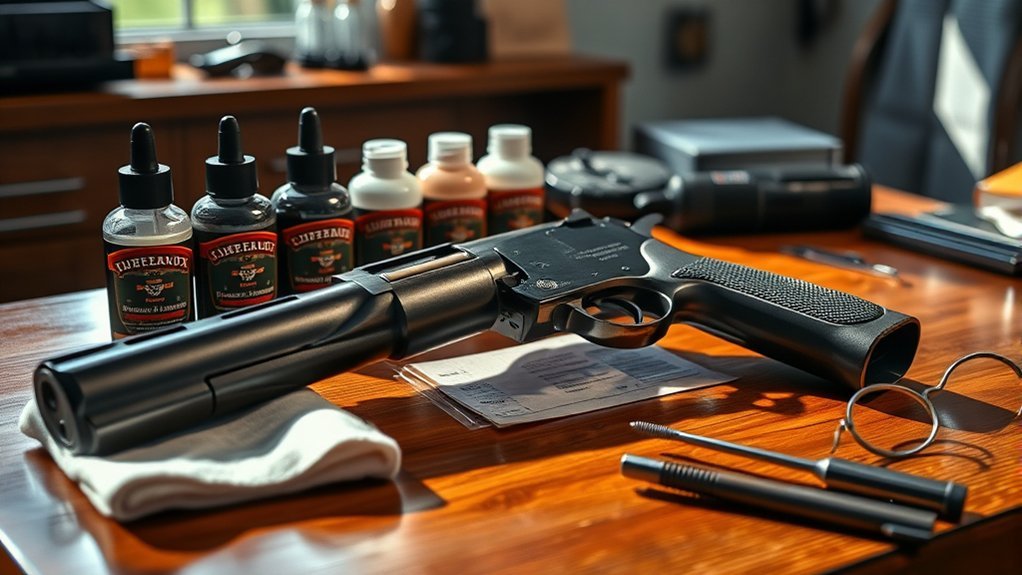When a firearm jams during critical use, the need for proper lubrication becomes painfully clear. You must understand that safe firearm lubrication is not just about keeping your weapon operational; it’s vital for longevity and performance. By recognizing the right techniques and products, you can prevent malfunctions and guarantee reliability. But how do you determine the best approach for your specific firearm? Let’s explore the key aspects of effective lubrication together.
Understanding the Importance of Firearm Lubrication

Firearm lubrication is essential for ensuring peak performance and longevity of your weapon. Proper lubrication reduces friction between moving parts, preventing wear and tear that can lead to malfunctions. When you keep your firearm well-lubricated, you enhance reliability, ensuring it functions correctly when you need it most. Additionally, lubrication helps to protect against corrosion and environmental damage, extending your firearm’s lifespan. You’ll also find that a lubricated weapon is easier to clean, as it prevents carbon buildup and fouling. Remember, different firearms have specific lubrication needs, so familiarize yourself with your weapon’s requirements. Regularly inspecting and applying the right lubricant will not only improve performance but also contribute to your safety and confidence while handling your firearm.
Common Misconceptions About Lubrication

While many gun owners understand the need for lubrication, several misconceptions can lead to improper maintenance practices. It’s essential to clarify these myths to guarantee your firearm remains in top condition:
Misconceptions about firearm lubrication can hinder proper maintenance, ensuring your firearm stays in optimal condition.
- More is better: Over-lubricating can attract dirt and cause malfunctions.
- Any oil will do: Not all oils are suitable for firearms; using the wrong type can damage components.
- Lubrication isn’t necessary for storage: Firearms need protection from moisture even when not in use.
- You can skip lubrication in cold weather: Cold temperatures can thicken lubricants, reducing effectiveness and risking performance.
Types of Lubricants: Oils vs. Greases

Understanding the types of lubricants is key to keeping your firearm operating smoothly. When it comes to firearm lubrication, oils and greases serve distinct purposes. Oils are typically lighter and penetrate tight spaces effectively, providing a thin film that reduces friction without attracting dust or debris. They’re ideal for areas that require frequent movement, like actions and triggers. On the other hand, greases are thicker and adhere better to surfaces, offering longer-lasting protection in high-stress areas, such as slides and rails. However, they can attract dirt if used improperly. Knowing when to use oils versus greases guarantees peak performance and longevity for your firearm, enhancing its reliability when you need it most. Choose wisely for the best results.
Choosing the Right Lubricant for Your Firearm
When choosing the right lubricant for your firearm, you need to evaluate the types available, such as oils and greases, and their specific applications. Each lubricant has its advantages, and knowing how to apply them properly is essential for peak performance. Don’t overlook safety factors, as the wrong lubricant can lead to malfunctions or unsafe conditions.
Types of Lubricants
Selecting the right lubricant for your firearm is essential for maintaining its performance and longevity. Various types of lubricants cater to different needs, ensuring your firearm operates smoothly. Here are some common options to evaluate:
- Oil-Based Lubricants: Great for general use, they provide excellent protection against rust and corrosion.
- Synthetic Lubricants: These offer superior performance in extreme temperatures, reducing friction effectively.
- Grease: Ideal for high-wear areas, it stays in place longer and provides a thicker protective barrier.
- Dry Lubricants: Perfect for dusty environments, they minimize dirt accumulation while reducing friction.
Application Techniques
Choosing the right application technique for your firearm lubricant is essential, as improper application can lead to performance issues or damage. Start by using a clean cloth or patch to wipe down surfaces, guaranteeing dirt and debris are removed. When applying lubricant, less is often more; a small amount on a clean applicator is usually sufficient. For precision parts, like the slide or bolt, use a needle applicator to target specific areas without over-saturating. Always allow the lubricant to penetrate for a few minutes before reassembling your firearm to guarantee peak performance. Regularly inspect and reapply as needed, particularly after extensive use or exposure to harsh conditions, to maintain your firearm’s reliability and longevity.
Safety Considerations
While the right lubricant can enhance your firearm’s performance, using the wrong one can lead to serious safety issues. To guarantee you’re making the best choice, consider these key factors when selecting your lubricant:
- Compatibility: Ensure the lubricant is suitable for your firearm’s materials (metal, plastic, etc.).
- Temperature Resistance: Choose a lubricant that can withstand the temperatures generated during firing.
- Non-Flammability: Opt for non-flammable options to minimize fire hazards.
- Cleanliness: Select a lubricant that doesn’t attract excessive dirt and debris, which can impair functionality.
Safe Application Techniques for Lubrication
When applying lubricant to your firearm, it’s essential to wear appropriate safety gear, such as gloves and goggles. You should also guarantee you’re working in a controlled environment to minimize any risks associated with the application process. By following these techniques, you can maintain both your safety and the integrity of your firearm.
Proper Safety Gear
Proper safety gear is vital for anyone handling firearms during lubrication. By equipping yourself appropriately, you minimize risks and guarantee a safer workspace. Here’s a list of essential safety gear you should always use:
- Safety goggles: Protect your eyes from splashes and debris.
- Nitrile gloves: Prevent skin contact with harmful lubricants and chemicals.
- Dust mask or respirator: Safeguard your lungs from inhaling fumes or particles.
- Apron or work shirt: Keep your clothing free from lubricant stains and contaminants.
Using the right gear not only enhances your safety but also promotes a more effective lubrication process. Make it a habit to double-check your equipment before you start, confirming you’re fully prepared for the task at hand.
Controlled Environment Practices
Creating a controlled environment for firearm lubrication is just as important as wearing the right safety gear. Verify you work in a well-ventilated area to prevent inhaling harmful fumes from lubricants. Maintain a clean workspace, free from dust and debris, as contaminants can compromise lubricant effectiveness. Use a drop cloth or tray to catch excess lubricant and avoid slips. Keep lubricants in their original containers, clearly labeled, to prevent mix-ups and accidental spills. Always have proper lighting to accurately see the components you’re working on, verifying you apply the right amount of lubricant. By following these controlled environment practices, you’ll not only enhance the longevity and performance of your firearm but also maintain a safer, more efficient workspace.
Frequency of Lubrication: How Often Should You Lubricate?
How often should you lubricate your firearm to guarantee peak performance? Regular lubrication is essential for maintaining your firearm’s reliability and longevity. Generally, you should lubricate your firearm under these conditions:
Regular lubrication is key to your firearm’s reliability and longevity; ensure you keep it well-maintained.
- After every 200-300 rounds fired
- After exposure to moisture or harsh conditions
- When storing for an extended period
- Before and after cleaning
Signs Your Firearm Needs Lubrication
Recognizing the signs that your firearm needs lubrication can greatly impact its performance and lifespan. If you notice sluggish action or resistance when cycling the action, it’s time to lubricate. Additionally, a decrease in accuracy can indicate friction caused by insufficient lubrication. You might also hear unusual noises, such as grinding or squeaking, which signal that the moving parts are not properly lubricated. If you observe rust or corrosion on metal surfaces, act immediately to prevent severe damage. Finally, after extensive usage or exposure to harsh conditions, always check for lubrication needs. Regularly inspecting these signs helps guarantee your firearm operates smoothly and reliably, ultimately enhancing your shooting experience.
Environmental Considerations for Lubrication
When considering lubrication for your firearm, it is vital to take environmental factors into account, as they can greatly influence both performance and longevity. Various conditions can affect how lubricants perform, leading to suboptimal results. Here are key considerations:
Consider environmental factors when lubricating your firearm to ensure optimal performance and longevity.
- Temperature: Extreme heat or cold can alter the viscosity of your lubricant, affecting its effectiveness.
- Humidity: High humidity levels can promote rust and corrosion, making moisture-resistant lubricants essential.
- Dust and Dirt: Environments with high particulate matter can cause abrasions, so consider lubricants that repel debris.
- Chemical Exposure: Avoid lubricants that may react negatively with cleaning agents or environmental pollutants.
Storing Your Firearm With Lubricants
When storing your firearm with lubricants, choosing the right product is essential to prevent corrosion and guarantee reliable function. Consider environmental factors, as moisture and temperature can affect both the lubricant and the firearm’s integrity. For long-term storage, follow best practices to maintain peak performance and safety.
Proper Lubricant Selection
How do you choose the right lubricant for storing your firearm? Selecting the appropriate lubricant is essential for protecting your firearm from corrosion and guaranteeing peak function. Here are some key factors to take into account:
- Viscosity: Choose a lubricant with the right thickness for your climate; too thin can evaporate quickly, while too thick can attract dust.
- Corrosion Resistance: Opt for lubricants specifically designed to prevent rust and corrosion, especially for long-term storage.
- Compatibility: Confirm the lubricant is safe for your firearm’s materials, such as metal, polymer, or wood.
- Application Method: Reflect on how easy it is to apply the lubricant. A spray or applicator bottle can make the process more efficient.
Environmental Considerations
Selecting the right lubricant isn’t just about performance; it also involves understanding the environmental impact of the products you use for storing your firearm. Many traditional lubricants contain harmful chemicals that can leach into the soil and water, posing risks to wildlife and ecosystems. Opt for biodegradable or eco-friendly lubricants that minimize this impact. When storing your firearm, make certain the lubricant doesn’t seep into areas where it can contaminate the environment. Additionally, be mindful of your cleaning practices, disposing of any excess or contaminated lubricant responsibly. By making informed choices about lubrication, you contribute to a safer environment while keeping your firearm in peak condition. Always read product labels to stay informed about the environmental implications of your selected lubricants.
Long-Term Storage Tips
To guarantee your firearm remains in ideal condition during long-term storage, it is crucial to apply the right lubricant effectively. Proper lubrication protects against rust and corrosion, ensuring your firearm is ready when you need it. Here are some key tips for long-term storage:
- Use a high-quality, non-gumming lubricant specifically designed for firearms.
- Apply a thin, even layer to all metal surfaces, focusing on moving parts.
- Store your firearm in a climate-controlled environment, away from humidity and extreme temperatures.
- Regularly check and reapply lubricant as necessary, especially if you notice any signs of moisture.
Maintenance Tips for Optimal Firearm Performance
While regular maintenance might seem tedious, it’s essential for guaranteeing peak firearm performance. Start by thoroughly cleaning your firearm after each use. Use a quality bore cleaner and patches to remove fouling from the barrel. Inspect all moving parts for wear and debris, applying a safe lubricant to reduce friction. Pay special attention to the trigger assembly and bolt mechanisms. Additionally, check and replace any worn springs or components to prevent malfunction. Store your firearm in a dry, climate-controlled environment to avoid corrosion. Finally, test fire your firearm periodically to verify everything functions correctly. By following these maintenance tips, you’ll enhance reliability and accuracy, ultimately securing your firearm’s longevity and performance when you need it most.
Conclusion
To sum up, keeping your firearm properly lubricated isn’t just about maintenance; it’s about ensuring reliability when it matters most. You might find it surprising how a few drops of the right lubricant can enhance performance and extend the life of your weapon. By understanding the importance of lubrication and recognizing the signs it needs attention, you’re not just protecting your investment—you’re ensuring your safety. So, take a moment to care for your firearm; it could make all the difference.

